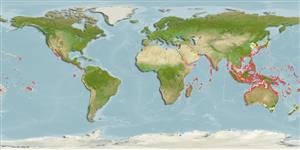Common names from other countries
Environment: milieu / climate zone / depth range / distribution range
Οικολογία
Υφαλόφιλο(α); εύρος βάθους 6 - 30 m (Ref. 83472). Tropical
Indo-Pacific.
Length at first maturity / Μέγεθος / Βάρος / Age
Maturity: Lm ? range ? - ? cm
Body is almost transparent, with small brown or purple spots present at the posterior carapace and sometimes the abdomen. Body has a distinct V-shaped white and yellow patch on the third abdominal tergum. Legs and tail are white, with blue or purple near the joints and tips. Rostrum is usually arched and toothed.
In shallow waters, to depths reaching 30 meters. Mainly associated with sea anemones, but also observed on hard corals and jellyfish (Ref. 125532).
Life cycle and mating behavior
Γεννητική Ωρίμανση | Αναπαραγωγή | Γεννοβολία | Αβγά | Γονιμότητα | Προνύμφες
Members of the order Decapoda are mostly gonochoric. Mating behavior: Precopulatory courtship ritual is common (through olfactory and tactile cues); usually indirect sperm transfer.
Li, X. and J.Y. Liu. 2004. (Ref. 81533)
IUCN Red List Status (Ref. 130435)
CITES status (Ref. 108899)
Not Evaluated
Not Evaluated
Human uses
| FishSource |
Εργαλεία
Περισσότερες πληροφορίες
Age/SizeΑύξησηLength-weightLength-lengthΜορφολογίαΠρονύμφεςΑφθονία
Διαδικτυακές πηγές
Estimates based on models
Preferred temperature
(Ref.
115969): 21.4 - 29.2, mean 28.3 (based on 3670 cells).
